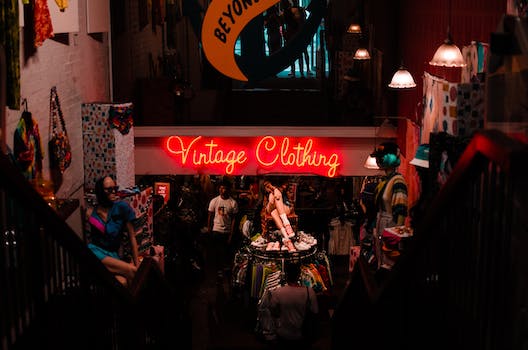How To Make Money Selling Vintage Clothes
“Unlock the hidden value in your closet with vintage clothing sales.”
Introduction
Selling vintage clothes can be a lucrative business for those who have an eye for fashion and a passion for history. Vintage clothing is defined as clothing that is at least 20 years old, and it can range from high-end designer pieces to everyday wear. With the rise of sustainable fashion and the popularity of vintage styles, there is a growing demand for vintage clothing. In this article, we will discuss how to make money selling vintage clothes.
Finding Hidden Gems: Tips for Sourcing Vintage Clothing to Sell
Are you a fashion enthusiast with a passion for vintage clothing? Do you have an eye for unique pieces that others may overlook? If so, you may be able to turn your love for vintage fashion into a profitable business. Selling vintage clothing can be a lucrative venture, but it requires a keen eye for quality and a knack for finding hidden gems. In this article, we’ll share some tips for sourcing vintage clothing to sell.
First and foremost, it’s important to know where to look for vintage clothing. Thrift stores, estate sales, garage sales, and flea markets are all great places to start. You can also try searching online marketplaces like eBay, Etsy, and Depop. When searching for vintage clothing, keep an open mind and be willing to dig through piles of clothes to find the hidden gems.
When sourcing vintage clothing, it’s important to pay attention to the quality of the garments. Look for pieces that are in good condition, with no major stains, tears, or holes. Check the seams and buttons to ensure they are secure. Vintage clothing that is in excellent condition will fetch a higher price and will be more appealing to buyers.
Another important factor to consider when sourcing vintage clothing is the style and era of the garment. Certain styles and eras are more popular than others, and will therefore sell for a higher price. For example, 90s grunge fashion is currently very popular, so vintage pieces from that era are in high demand. Do some research on current fashion trends and popular vintage styles to help guide your sourcing efforts.
When sourcing vintage clothing, it’s also important to consider the size and fit of the garments. While some buyers may be willing to alter a garment to fit them, most prefer to purchase items that fit them well right off the rack. Look for pieces in a range of sizes to appeal to a wider audience.
Once you’ve sourced your vintage clothing, it’s time to start selling. Online marketplaces like eBay, Etsy, and Depop are great places to start. Take clear, well-lit photos of your garments and write detailed descriptions that highlight the unique features of each piece. Be honest about any flaws or imperfections, as this will help build trust with buyers.
When pricing your vintage clothing, it’s important to consider the condition, style, and rarity of the garment. Do some research on similar items to get an idea of what they are selling for. Don’t be afraid to start with a higher price and negotiate with buyers if necessary.
In addition to online marketplaces, you can also sell your vintage clothing at local flea markets, vintage fairs, and pop-up shops. These events provide a great opportunity to connect with buyers in person and showcase your unique pieces.
In conclusion, sourcing and selling vintage clothing can be a profitable and rewarding venture for fashion enthusiasts. By following these tips and staying up-to-date on current fashion trends, you can turn your love for vintage fashion into a successful business. Happy sourcing and selling!
Pricing Your Pieces: Strategies for Setting Competitive Prices

Are you a vintage clothing enthusiast looking to turn your passion into profit? Selling vintage clothes can be a lucrative business, but pricing your pieces can be a challenge. In this article, we’ll explore some strategies for setting competitive prices that will help you make money selling vintage clothes.
First, it’s important to do your research. Look at what similar items are selling for on online marketplaces like Etsy, eBay, and Depop. Take note of the condition, brand, and rarity of the items, as these factors can greatly affect the price. You can also visit local vintage shops and thrift stores to get an idea of what prices are like in your area.
Once you have a general idea of what prices are like, it’s time to consider the condition of your items. Vintage clothing can range from pristine to heavily worn, and the condition will greatly affect the price. Be honest with yourself about the condition of your pieces and price accordingly. If an item has stains, holes, or other damage, it will likely sell for less than a similar item in excellent condition.
Another factor to consider is the brand of the item. Certain vintage brands, like Levi’s and Wrangler, are highly sought after and can command higher prices. Do some research on popular vintage brands and price your items accordingly. However, don’t assume that just because an item is from a popular brand that it will automatically sell for a high price. Condition and rarity are still important factors to consider.
Rarity is another important factor to consider when pricing your vintage clothes. If you have a one-of-a-kind item or something that is difficult to find, you can likely charge a higher price. However, if an item is common or easily found, you may need to price it lower to make a sale.
When setting prices, it’s also important to consider your target market. Are you selling to collectors or casual vintage enthusiasts? If you’re selling to collectors, you may be able to charge higher prices for rare or highly sought after items. However, if you’re selling to casual vintage enthusiasts, you may need to price your items lower to appeal to a wider audience.
Finally, don’t be afraid to negotiate. Many buyers expect to haggle when buying vintage clothes, so be prepared to negotiate on price. However, don’t undervalue your items just to make a sale. Know your bottom line and be willing to walk away if a buyer isn’t willing to pay a fair price.
In conclusion, pricing your vintage clothes can be a challenge, but with some research and consideration of factors like condition, brand, rarity, and target market, you can set competitive prices that will help you make money selling vintage clothes. Don’t be afraid to negotiate, but also know your bottom line and don’t undervalue your items. With these strategies in mind, you’ll be well on your way to a successful vintage clothing business.
Creating a Killer Online Store: Tips for Building a Successful E-Commerce Site
Are you a vintage clothing enthusiast looking to turn your passion into profit? Selling vintage clothes online can be a lucrative business if done correctly. With the rise of e-commerce, it’s easier than ever to reach a global audience and build a successful online store. Here are some tips for creating a killer online store and making money selling vintage clothes.
1. Choose a Niche
The first step in building a successful online store is to choose a niche. While it may be tempting to sell a wide variety of vintage clothing, it’s better to focus on a specific niche. This will help you stand out from the competition and attract a loyal customer base. Some popular vintage clothing niches include 90s grunge, 70s bohemian, and 50s pin-up.
2. Source Quality Inventory
The key to selling vintage clothes is to source quality inventory. This means finding items that are in good condition, on-trend, and unique. You can source inventory from thrift stores, estate sales, and online marketplaces like eBay and Etsy. It’s important to do your research and only purchase items that you know will sell.
3. Build a User-Friendly Website
Once you have your inventory, it’s time to build your online store. A user-friendly website is essential for attracting and retaining customers. Your website should be easy to navigate, visually appealing, and mobile-friendly. You should also include high-quality photos and detailed descriptions of each item.
4. Use Social Media to Promote Your Store
Social media is a powerful tool for promoting your online store. You can use platforms like Instagram and Facebook to showcase your inventory, engage with customers, and drive traffic to your website. It’s important to post regularly and use relevant hashtags to reach a wider audience.
5. Offer Excellent Customer Service
Customer service is key to building a successful online store. You should respond to customer inquiries promptly and professionally, and offer a hassle-free return policy. You should also package and ship items with care to ensure they arrive in good condition.
6. Price Your Items Competitively
Pricing your items competitively is essential for making sales. You should research the market and price your items accordingly. While it may be tempting to price items high to maximize profit, it’s important to remember that customers are looking for a good deal. You should also offer discounts and promotions to incentivize customers to make a purchase.
7. Stay Up-to-Date with Trends
The vintage clothing market is constantly evolving, so it’s important to stay up-to-date with trends. You should research current fashion trends and incorporate them into your inventory. You should also pay attention to what’s selling well and adjust your inventory accordingly.
In conclusion, selling vintage clothes online can be a profitable business if done correctly. By choosing a niche, sourcing quality inventory, building a user-friendly website, using social media to promote your store, offering excellent customer service, pricing your items competitively, and staying up-to-date with trends, you can build a successful online store and make money selling vintage clothes.
Marketing Your Vintage Clothing Business: Strategies for Reaching Your Target Audience
Are you a vintage clothing enthusiast looking to turn your passion into a profitable business? Selling vintage clothes can be a lucrative venture, but it requires more than just a love for fashion. To succeed in this industry, you need to have a solid marketing strategy that will help you reach your target audience. In this article, we will discuss some effective marketing strategies that will help you sell your vintage clothes and grow your business.
1. Define Your Target Audience
The first step in marketing your vintage clothing business is to define your target audience. Who are the people that are most likely to buy your vintage clothes? Are they young adults, fashion enthusiasts, or collectors? Once you have identified your target audience, you can tailor your marketing efforts to reach them effectively.
2. Create a Brand Identity
Creating a brand identity is crucial in any business, and it is no different for a vintage clothing business. Your brand identity should reflect your unique style and personality. It should also be consistent across all your marketing channels, including your website, social media, and packaging. A strong brand identity will help you stand out from your competitors and attract more customers.
3. Build a Website
In today’s digital age, having a website is essential for any business. Your website should be visually appealing, easy to navigate, and provide all the necessary information about your vintage clothing business. You can also use your website to sell your vintage clothes online, which can significantly increase your reach and sales.
4. Use Social Media
Social media is a powerful marketing tool that can help you reach a broader audience. You can use platforms like Instagram, Facebook, and Twitter to showcase your vintage clothes, engage with your followers, and promote your business. Make sure to post high-quality photos of your vintage clothes and use relevant hashtags to increase your visibility.
5. Attend Vintage Clothing Fairs and Markets
Attending vintage clothing fairs and markets is an excellent way to reach your target audience and promote your business. These events attract vintage clothing enthusiasts and collectors, making them the perfect place to showcase your vintage clothes. You can also network with other vintage clothing sellers and learn about the latest trends in the industry.
6. Collaborate with Influencers
Collaborating with influencers is a great way to reach a wider audience and promote your vintage clothing business. You can partner with fashion bloggers, Instagram influencers, and YouTubers to showcase your vintage clothes and reach their followers. Make sure to choose influencers that align with your brand identity and target audience.
7. Offer Discounts and Promotions
Offering discounts and promotions is an effective way to attract new customers and retain existing ones. You can offer discounts on specific items, free shipping, or bundle deals to encourage customers to buy more. Make sure to promote your discounts and promotions on your website and social media channels to increase their visibility.
In conclusion, marketing your vintage clothing business requires a combination of creativity, strategy, and persistence. By defining your target audience, creating a brand identity, building a website, using social media, attending vintage clothing fairs, collaborating with influencers, and offering discounts and promotions, you can reach your target audience and grow your business. Remember to stay true to your unique style and personality, and always provide excellent customer service to keep your customers coming back.
Building a Brand: How to Establish Yourself as a Go-To Source for Vintage Fashion
Are you a vintage fashion enthusiast looking to turn your passion into a profitable business? Selling vintage clothes can be a lucrative venture if you know how to establish yourself as a go-to source for vintage fashion. In this article, we’ll share some tips on how to build a brand and become a successful vintage clothing seller.
First and foremost, it’s important to have a clear understanding of your target audience. Who are the people that are most likely to buy vintage clothes? What are their interests and preferences? Once you have a good idea of your target audience, you can start curating a collection of vintage clothes that will appeal to them.
When building your collection, it’s important to focus on quality over quantity. Don’t just buy any vintage clothes you come across – take the time to carefully select pieces that are in good condition and have a unique style. This will help you establish yourself as a seller of high-quality vintage fashion.
Once you have a collection of vintage clothes, it’s time to start building your brand. One of the most effective ways to do this is by creating a strong online presence. Start by setting up a website or online store where customers can browse and purchase your vintage clothes. Make sure your website is visually appealing and easy to navigate, and include detailed descriptions and high-quality photos of each item.
In addition to your website, it’s important to have a strong social media presence. Use platforms like Instagram and Facebook to showcase your collection and connect with potential customers. Post photos of your vintage clothes, share styling tips, and engage with your followers by responding to comments and messages.
Another way to establish yourself as a go-to source for vintage fashion is by attending vintage fairs and markets. These events are a great way to connect with other vintage enthusiasts and showcase your collection to a wider audience. Make sure to bring your best pieces and have business cards or flyers on hand to promote your online store.
When it comes to pricing your vintage clothes, it’s important to do your research and set fair prices. Look at what other vintage sellers are charging for similar items, and take into account factors like the condition and rarity of the piece. Don’t be afraid to negotiate with customers, but also don’t undervalue your collection.
Finally, it’s important to provide excellent customer service to build a loyal customer base. Respond to customer inquiries and concerns in a timely and professional manner, and make sure to package and ship your vintage clothes with care. A positive customer experience can go a long way in building a strong brand and repeat business.
In conclusion, building a successful vintage clothing business requires a combination of quality products, a strong online presence, and excellent customer service. By following these tips, you can establish yourself as a go-to source for vintage fashion and turn your passion into a profitable business.
Conclusion
Conclusion: Selling vintage clothes can be a profitable business if done correctly. It requires knowledge of the market, a good eye for quality pieces, and effective marketing strategies. By following these tips, you can increase your chances of success and make money selling vintage clothes.






